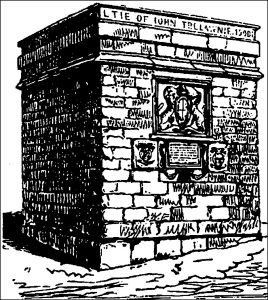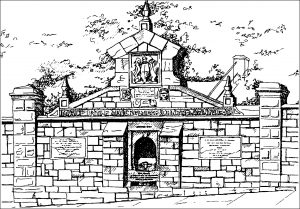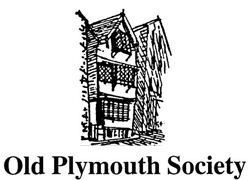by Ray Bush
Published May 2012
Many of the historic stone commemorative reminders of Plymouth’s yesteryears, inclusive inscriptions, coats of arms, dates, etc., are being badly eroded. Before it is too late and such legends become totally illegible, perhaps their details, inclusive interesting facets of their origins, should be recorded within the Society’s Journals or Newsletters. One such interesting group of inscriptions is that associated with Drakes Place and Reservoirs at North Hill and is thus so selected to commence an occasional series of Lest We Forget.
In addition to the many wells, springs, streams, etc., of early Tudor Plymouth, various water distribution points called ‘conduits’ existed and normally consisted of an open-ended pipe to enable buckets to be filled as required. A stream originating near Glanville Street (south of the main University building) supplied such a ‘conduit’ just outside the Old Town Gate and was situated roughly where the north entrance into the C. & A. store in Drake Circus now stands.
Once Drake’s Leat had been completed in 1591, surplus water was soon used to supplement the original water distribution for the Town, inclusive the Old Town conduit, and naturally, over the years, the conduit was modified, rebuilt or renovated as required, until in 1834 it became the last such conduit to be pulled down and removed as no longer required when more and more houses were fed direct by pipes.
Quite what this conduit looked like from 1591 to 1671, we shall never know, but we do know that in 1671 it was totally rebuilt as an eight foot square limestone block roofless building, some eight feet in height, with an open doorway in one wall and the pipe, eventually fitted with tap, placed at a convenient height within the structure. One external wall was embellished with the coat of arms, a stone inscribed ‘Sir Francis Drake first brought this water into Plymouth in 1591. This conduit was new built in the Maioralty of William Cotton,Merchant, 1671’.
Left of this inscription was a carved stone bearing the Plymouth Coat of Arms and, on the right, Drake’s Coat of Arms with odd scroll work below and either side of the inscribed stone.
To the top of each wall was added a section of blocks with the embossed legend ‘Made in the Maioraltie of John Trelawnye 1598’ but as the whole legend was some sixteen feet in length, it had to be carried around two walls!
It is virtually certain that this legend was not on the original conduit but from where it came to be incorporated into the 1671 rebuild is unknown.
Although the conduit had actually ceased to operate during 1827, when news of its removal became known there was an outcry to preserve it so the front face (or wall) was incorporated into the existing wall of the new reservoirs on Tavistock Road, with the main legend ‘Made in the Maioraltie of John Trelawnye 1598′ running along the top of the wall. The sketch below of the conduit was drawn in February 1834, by George Wightwick, just a couple of weeks prior to its removal. In addition to the items from the old conduit being affixed to the reservoirs wall, a new inscribed stone was also affixed reading `Removed from Old Town Street and re-erected on this spot in the mayoralty of William Hole Evens, Esq., 1834’.
So the conduit ‘bits and pieces’ remained for a further forty years but in 1874, following the demolition of the old cottages (that had stood on the site of the original two mills since Drake’s days), the wall around that area had to be rebuilt.

As this also contained the conduit relics, the whole was removed and rebuilt into the designed structure that exists today and as so illustrated by Chris Robinson’s fine sketch below.
This new wall included a gable style top section to carry the Charles II, Drake and Town coats of arms as well as the original 1671 inscription stone, thus the old conduit relics were now positioned above the legend ‘Made in the Maioraltie of John Trelawnye, 1598’ as that was now positioned at the base of the gable. There was therefore no room left for the stone inscribed ‘Removed from Old Town Street and re-erected on this spot in the Mayoralty of William Hole Evens, Esq, 1834’ so this stone was repositioned on the back face of the gable, immediately behind the original 1671 stone and remains so today.
The new wall itself was designed to accommodate a recessed drinking fountain, above which is the embossed legend ‘Erected 1874’ and, beneath it ‘This trough is part of one of the channels by which water was distributed through the Town’. As the 1834 tablet had been removed to the rear of the gable, a new tablet was affixed to the left of the trough and carried the legend `The stone carvings above are parts of the public conduit removed from the head of Old Town Street in 1834, William Hole Evens mayor. The wall and carvings re-erected 1874 in the second Mayoralty of Alfred Rooker. James King, chairman of the Water Committee’.
To balance up the overall appearance of the new structure, another tablet of equal size was positioned on the right hand side of the drinking fountain and this carried the legend ‘The south Reservoir was made in the third Mayoralty of Edmund Lockyer 1825. The north Reservoir in 1828 during the Mayoralty of Richard Pridham’.
As regards tablet inscriptions concerning the reservoirs themselves, as well as the one to the right of the drinking fountain on the outside wall as mentioned above, two others are positioned within the now locked reservoir grounds. The first reads ‘This Resevoir was made in the Mayoralty of Edmund Locker Esquire, being the third time of his filling that high and important office, Anno Domini 1825’ the second reads ‘This Reservoir was reconstructed in the Mayoralty of J.T. Bond, Esq, 1891. Isaac Latimer, J.P., Chairman of the Water Committee; George Barrett Deputy Chairman; C.D. Bellamy, C.E., Borough and Water Engineer.’ As can be appreciated, one reservoir was built in 1825, a second separate one in 1828 and the two were amalgamated and enlarged in 1891.
At the eastern end (Tavistock Road – Drake Circus – end) of the Colonnade in Drake’s Gardens, is a stone tablet with the legend ‘Erected in the Mayoralty of J.T. Bond Esq, Isaac Latimer J.P. Chairman of the Water Committee; Geo R. Barrett, Deputy Chairman, 1891’ and at the western end of the Colonnade on a tower structure, a stone tablet which reads ‘Built in the Mayoralty of John Morshead, Esq, 1754, under the direction of Jos Collier, Esq’ BUT why was this very minor 1754 structure so important as to warrant such an inscription??

Further to this article, a letter to the OPS editor from Doreen Mole:
Sir,
In his article about the conduit remnants and associated commemorative stones, “Lest We Forget”, March 1998 Newsletter, Ray Bush ends with “at the western end of the colonnade on a tower structure, a stone tablet which reads `Built in the Mayoralty of John Morshead, Esq, under the direction of Jos Collier, Esq’. BUT why was this very minor 1754 structure so important as to warrant such an inscription?”
The answer to this question comes, I think, from the town records quoted by Jewitt in his History of Plymouth, a paragraph which reads:
1753 – John Morshead, Mayor. The water house at the Higher mills rebuilt with stone, previously it was built of wood.
